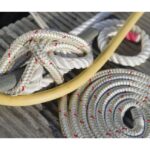Nautical vocabulary might seem silly at first, but it can be incredibly useful! Besides sounding like you know what you’re talking about, in case of emergency using the right term can save valuable time. If you plan on spending time on the water, you should take a minute to learn about the words of the sea.
First, directions on board are different than they are on land. Port & starboard (left and right) are oriented towards the boat and never change. Towards the bow is forward, towards the stern is aft. If someone is on deck, they are said to be abovedeck. If they’re inside the boat, they are said to be below.
Next, the various parts of the boat all have different names. The hull is the body of the boat. On all but the smallest crafts, the hull has a keel, a long, linear structure on the bottom of the boat that helps it stay balanced in the water. Larger boats and yachts have a superstructure that sits above the deck of the boat, often with a flybridge (a secondary, elevated steering area that’s often open or covered only by a bimini top). The flat edge of the stern, where a small door to step onto the boat is often located, is known as the transom. Finally, there is a line painted on the hull just above the water. This is the waterline, which marks the correct displacement of the vessel.
Finally, the different areas inside the vessel have new names as well. The kitchen is known as the galley, and is often located adjacent to or in the salon (living area). The staterooms or cabins (bedrooms) contain beds known as berths. The bathroom is called the head.
This is a lot of information to process all at once, and even more to remember. The best way to remember all of it is to put it into practice, so find a way to get out onto the water! Ask a friend with a boat for a Saturday out on the bay, or call up your friendly neighborhood yacht broker if you’re ready to buy a boat for yourself!





